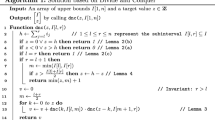Abstract
We examine the problem of integer representation in near minimal number of bits so that increment and decrement (and indeed addition and subtraction) can be performed using few bit inspections and fewer bit changes. In particular, we prove a new lower bound of \(\Omega(\sqrt{n})\) for the increment and decrement operation, where n is the minimum number of bits required to represent the number. The model of computation we considered is the bit probe model, where the complexity measure counts only the bitwise accesses to the data structure. We present several efficient data structures to represent integer that use a logarithmic number of bit inspections and a constant number of bit changes per operation.
This work was supported by NSERC of Canada and The Canada Research Chairs Program.
Access this chapter
Tax calculation will be finalised at checkout
Purchases are for personal use only
Preview
Unable to display preview. Download preview PDF.
Similar content being viewed by others
References
Boothroyd, J.: Algorithm 246 Graycode. Communications of the ACM 7(12), 701 (1964)
Buhrman, H., Miltersen, P.B., Radhakrishnan, J., Venkatesh, S.: Are Bitvectors Optimal? SIAM Journal on Computing 31(6), 1723–1744 (2002)
Carlsson, S., Munro, J.I., Poblete, P.V.: An Implicit Priority Queue with Constant Insertion Time. In: Karlsson, R., Lingas, A. (eds.) SWAT 1988. LNCS, vol. 318, pp. 1–13. Springer, Heidelberg (1988)
Clancy, M.J., Knuth, D.E.: A Programming Problem-Solving Seminar. Tech Report, Computer Science Dept. School of Humanities and Science, Stanford University. STAN-CS-77-606 (1977)
Doran, M.W.: The Gray Code. CDMTCS Research Report (2007), www.cs.auckland.ac.nz/CDMTCS//researchreports/304bob.pdf
Er, M.C.: Remark on Algorithm 246 (Gray Code). ACM Transactions on Mathematical Software 11(4), 441–443 (1985)
Erdös, P., Rado, R.: Intersection Theorems for Systems of Sets. Journal of the London Mathematical Society 35, 85–90 (1960)
Frandsen, G.S., Miltersen, P.B., Skyum, S.: Dynamic Word Problems. Journal of the ACM 44, 257–271 (1997)
Fredman, M.L.: Observations on the Complexity of Generating Quasi-Gray Codes. SIAM Journal on Computing 7, 134–146 (1978)
Gray, F.: Pulse Code Communications. U.S. Patent 2632058 (1953)
Lucal, H.: Arithmetic Operations for Digital Computers Using a Modified Reflected Binary Code. IEEE Transactions on Computers, 449–458 (1959)
Miltersen, P.B.: Lower Bounds on the Size of Selection and Rank Indexes. In: Proceedings of the 16th ACM/SIAM SODA, pp. 11–12 (2005)
Minsky, M., Papert, S.: Perceptrons. MIT Press, Cambridge (1969)
Misra, J.: Remark on Algorithm 246:Graycode[Z]. ACM Transactions on Mathematical Software 1(3), 285 (1975)
Pätraşcu, C.E., Pätraşcu, M.: On Dynamic Bit-Probe Complexity. In: Caires, L., Italiano, G.F., Monteiro, L., Palamidessi, C., Yung, M. (eds.) ICALP 2005. LNCS, vol. 3580, pp. 969–981. Springer, Heidelberg (2005)
Radhakrishnan, J., Raman, V., Rao, S S.: Explicit Deterministic Constructions for Membership in the Bitprobe Model. In: Meyer auf der Heide, F. (ed.) ESA 2001. LNCS, vol. 2161, pp. 290–299. Springer, Heidelberg (2001)
Yao, A.C.C.: Should Tables be Sorted? Journal of The ACM 28, 615–628 (1981)
Author information
Authors and Affiliations
Editor information
Rights and permissions
Copyright information
© 2007 Springer-Verlag Berlin Heidelberg
About this paper
Cite this paper
Rahman, M.Z., Munro, J.I. (2007). Integer Representation and Counting in the Bit Probe Model. In: Tokuyama, T. (eds) Algorithms and Computation. ISAAC 2007. Lecture Notes in Computer Science, vol 4835. Springer, Berlin, Heidelberg. https://doi.org/10.1007/978-3-540-77120-3_3
Download citation
DOI: https://doi.org/10.1007/978-3-540-77120-3_3
Publisher Name: Springer, Berlin, Heidelberg
Print ISBN: 978-3-540-77118-0
Online ISBN: 978-3-540-77120-3
eBook Packages: Computer ScienceComputer Science (R0)




